mobile View, to the German Version tap the flag


- Australia / Australian Federation
- parliamentary federal monarchy with the British monarch as Head of State
- own name: Commonwealth of Australia
• Flags
• Historical Flag
• Aboriginal flag
• unofficial Flags
• Meaning/Origin of the Flag
• Coat of Arms
• Meaning/Origin of the Coat of Arms
• Aircraft Roundel
• Map
• Numbers and Facts
• Federal States, Colonies, Territories
• History
• Origin of the Country's Name
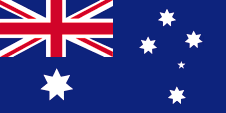
National flag und Naval jack,
ratio = 1:2,
Source, by: Flags of the World





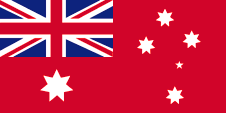
Merchant flag,
ratio = 1:2,
Source, by: Flags of the World



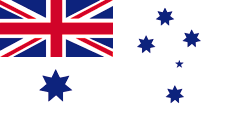
Naval flag,
ratio = 1:2,
Source, by: Flags of the World



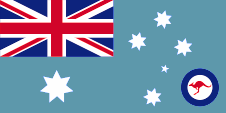
Flag of the Air Force,
ratio = 1:2,
Source, by: Flags of the World



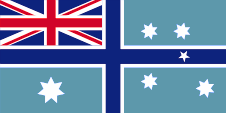
Civil Air Ensign,
ratio = 1:2,
Source, by: Flags of the World



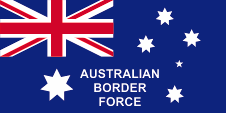
since 2015,
Flag of the Border Force,
ratio = 1:2,
Source, by: Wikipedia (EN)



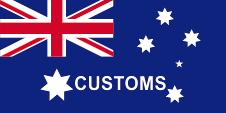
Customs flag,
ratio = 1:2,
Source, by: Wikipedia (D)



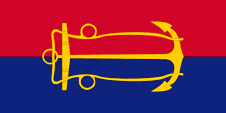
Flag of the Navy Board,
ratio = 1:2,
Source, by: Wikipedia (EN)



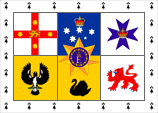
1953–2022,
Flag of the Queen,
ratio = 5:7,
Source, by: Wikipedia (EN)





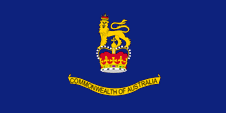
Flag of the Governor General,
ratio = 1:2,
Source, by: Wikipedia (EN)




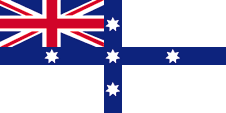
to 1901,
Flag of the Federation Movement,
ratio = 1:2,
Source, by: Die Welt der Flaggen




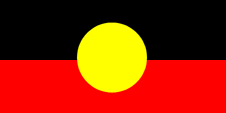
Aboriginal flag,
ratio = 1:2,
Source, by: Wikipedia (EN),
Die Welt der Flaggen



The flag of the 150.000 natives of Australia (Aboriginals) is now well known internationally. It is a design by the Aboriginal Harold Thoms and was hoisted for the first time in 1971. Black stands for the people, red for the land, and the yellow disk for the sun.
Source: Die Welt der Flaggen

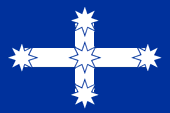
1854,
The Eureka-Flag,
ratio = 2:3,
Source, by: Wikipedia (EN)





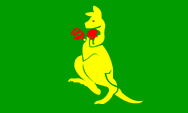
1983,
The Boxing-Kangaroo-Flag,
ratio = 3:5,
Source, by: Wikipedia (EN)





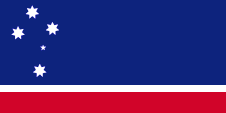
1986,
The Ausflag,
ratio = 1:2,
Source, by: Die Welt der Flaggen,
Ausflag Competitions




Australia uses the British ensign system, which means single clolour buntings with a flag design – the British Union Jack – in the upper staff quadrant. The color of the ground cloth of the flag is so governed by its use. The Union Jack points to the connexions to the United Kingdom in any case. The United Kingdom introduced a flag system in 1864 in which:
• war ships fly the "White Ensign" (naval flag), a white flag often with an uninterrupted red St. George's-Cross and with the Union Jack in the upper staff quadrant of the flag,
• merchant ships fly a "Red Ensign" (also named "Civil Ensign" => civil flag, the real merchant flag), a red flag with the Union Jack in the upper staff quadrant of the flag, and
• governmental ships fly the "Blue Ensign" (flag for the use by the gouvernment => the actual state flag), a blue flag with the Union Jack in the upper staff quadrant of the flag.
Since 1865 ships of colonial governments were permitted to fly the Blue Ensign with a badge in the flying end of the flag. The respective governments were asked to design appropriate badges. Merchant ships and seafaring persons from colonies were only permitted to use the Red Ensign with a badge, then also named Civil Ensign, if permission has been given to the respective colony by the British admiralty.
When one searched for a common flag for the united colonies of Australia, as the flag of the Federation Movement should obviously not be used, a competition was organized in 1901, in which the design of today's Australian flag won. It shows a seven-point white star under the "Union Jack". It was initially added in 1909 as six-point star, and symbolizes the federal states and the territories. In the flying end of the flag the "Southern Cross/Crux", a wide-spread symbol in the area of the Pacific Ocean, consisting of one five-point and four seven-point stars. In its current form, the flag was introduced on 22nd of May in 1909 and was confirmed on 15th of April in 1954.
Derived from the coat of arms of Australia is the flag of the Queen. Her deputy is the Governor-General of Australia. His flag is, as decided in the Statute of Westminster of 1931 for all dominions, single colour blue with the Royal Crest in the centre. Underneath very often the name of the dominion, as also in the case of Australia, within a ribbon.
Again and again there are discussions in Australia about changing the flag, and diverse unofficial flags circulate in the land. Background is the refusal of British symbolism, which is perceived as dated or un-Australian. The most popular of the current three unofficial flags, the "Boxing Kangaroo", is very often in use by the Australians. Initially, it is a ”jest flag” with the Australian national colours of green and yellow, possibly borrowed from the acacia foliage of the coat of arms. The second unofficial flag, which is mostly popular by intellectuals, is the "Eureka-Flag". At a miner-revolt on November 29th, 1854 in the village of Eureka Stockade an independent republic was proclaimed. Before the police and the army quelled the revolt, a blue flag flew with a white cross in the centre and five white eight-point stars at the ends of the arms of the cross and in its centre. The blue symbolized the heavens – which belongs to all residents of the planet –, the hope and the freedom. The third unofficial flag is the "Ausflag". It was created on the occasion of the 200-year-celebrations in 1988 by the Ausflag-Organization. It ist a compromise between the deletion of British symbolism and and maintaining the colours.
Source: Die Welt der Flaggen,
Flaggen und Wappen,
Flaggen Wappen Hymnen, Translator of the English text: Joachim Nuthack

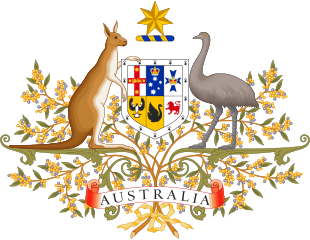
Coat of arms of Australia,
Source: Sodacan, Public domain, via Wikimedia Commons

The coat of arms was awarded by the British King George I. to Australia on September 20th, 1912. In the divided and halved shield are simplified emblems (badges) of the respective federal states: in a silvery field the red Cross of St. George with a golden walking lion and four golden eight-point stars (New South Wales), five silvery stars on blue ground with the British Crown (Victoria), in a silvery field the blue Maltese Cross with the British Crown in the centre (Queensland), the Australian Shrike in a golden field (South Australia), the black swimming swan in a golden field (West Australia) and a red walking lion in a silvery field (Tasmania). The shield is framed by ermine fur, which symbolizes the indivisibility of the state. Shield holders are a kangaroo and an emu. Above the shield, on a golden-blue torus, a golden seven-point star (Commonwealth Star). The coat of arms is surrounded by acacia twigs with leafs and fruits. A silvery ribbon contains the name of the state.
Source:
Die Welt der Flaggen,
Flaggen und Wappen,
Flaggen Wappen Hymnen, Translator of the English text: Joachim Nuthack

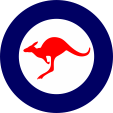
since 1982(?),
Aircraft Roundel,
Source, by: Wikipedia (EN)
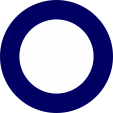
1942–1946,
Aircraft Roundel,
Source, by: Wikipedia (EN)
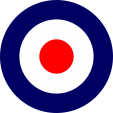
1921–1982(?),
Aircraft Roundel

Location:
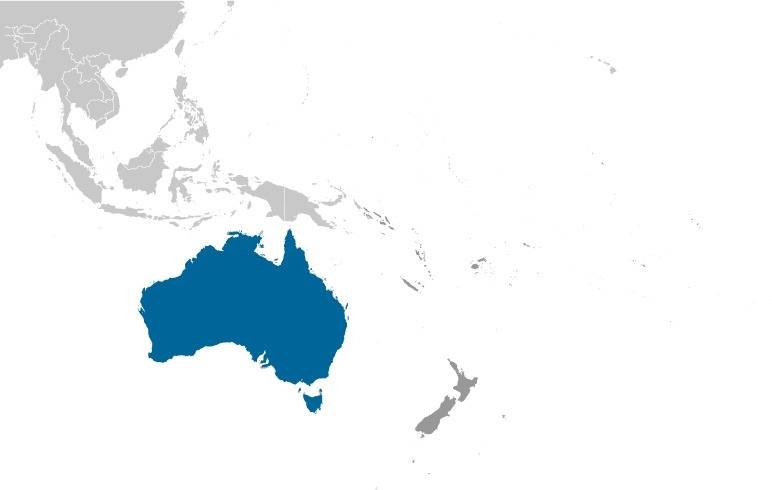
Source: CIA World Factbook
Map of the country:
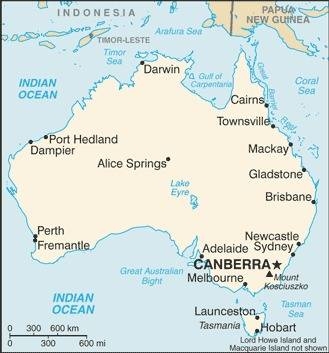
Source: CIA World Factbook
Clickable Map:
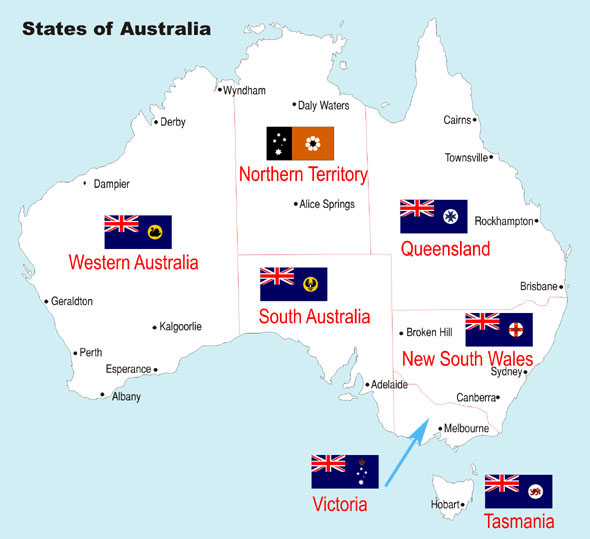
Source: Corel Draw 4, modyfied by: Volker Preuß

Area: 2.968.450 square miles
Inhabitants: 25.325.000 (2019), thereof 92% Europeans (including ca. 898.500 Germans and German descendants), 7% Asians, 2% Aborigines
Religions: 52% Christian, 2% Buddhist, 2% Muslim, 30% Non-Religious
Density of Population: 9 inh./sq.mi.
Capital: Canberra, 395.790 inh. (2016)
official Language: English
other Languages: Chinese, Arabic, Greek, Italian, Vietnamese
Currency: 1 Australian Dollar ($A, A$, AU$, AUD) = 100 Cents
Time Zone: GMT + 8 to + 11 h
Source: Wikipedia (D),
CIA World Factbook

Federal States:
New South Wales, Queensland, South Australia, Tasmania, Victoria, Western Australia
Territories:
Northern Territory, Capital Territory
Colonies:
Norfolk Island, Christmas Island, Cocos Islands
other Territories
Torres Strait Islands, Lord Howe Island

1606 · discovered by Dutch seafarers
1770 · British appropriation (J. Cook)
1788 · first British colonization
1901 · formation of the Australian Federation (the colonies become to independent states within a federation)
1913 · Canberra becomes capital
1933 · plebiscite for a independent Western Australia
1986 · full sovereignty for Australia
Source: Weltgeschichte,
Wikipedia (D),
Atlas zur Geschichte

From antiquity to the Middle Ages, a suspected and repeatedly mentioned and mapped southern continent was given the name "Terra Australis" or "Terra australis incognita". From the 16th and 17th centuries, seafarers kept looking for this continent. In 1606 Pedro Fernández de Quirós discovered the New Hebrides (now Vanuatu) and he named a land mass (the island of Espiritu Santo) that seemed very large to him "La Austrialia del Espiritu Santo". Today's Australia was discovered by Dutch sailors and was visited repeatedly (1606 Willem Jansz → Cape York Peninsula, 1616 Dirk Hartog → west coast, 1619 Frederick de Houtman → west coast, 1696 Willem de Vlamingh → west coast). An expedition of the Dutch East India Company (VOC) led the navigator Abel Tasman past Antarctica in the south and he discovered a large island which he called "New Holland". This name was transfered to the entire, slowly discovered land mass of the "Terra incognita", the Australian subcontinent. Because at the coasts of New Holland were mostly covered with deserts, there was initially no economic interest. The British captain James Cook reached the fertile eastern coast in 1770, which he took in possession as "New South Wales" for the United Kingdom. In the following years various British colonies were founded on the continent, e.g. Van Diemen’s Land (1825), South Australia (1836) etc., which was the first time the word "Australia" appeared in a country's name. These six British colonies merged in 1901 in the Commonwealth of Australia. Finally, the island of "New Holland" was renamed to "Tasmania" by the British in 1824 in honor of its European explorer Abel Tasman.
Source:
1.)
Wikipedia (D),
2.)
Wikipedia (D)


![]()

























































